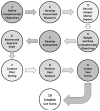Development and validation of an assessment tool for a national young worker curriculum
- PMID: 27711978
- PMCID: PMC5180418
- DOI: 10.1002/ajim.22610
Development and validation of an assessment tool for a national young worker curriculum
Abstract
Background: An online, multiple-choice assessment was developed and validated for Youth@Work-Talking Safety, a NIOSH curriculum that equips middle and high school students with foundational workplace safety and health knowledge and skills.
Methods: Classical Test Theory was used for the test development and validation; the Jaeger method was used for cut score determination. A total of 118 multiple-choice items were developed to measure the acquisition of knowledge and skills taught through the NIOSH curriculum. Pilot testing was conducted with 192 8-12th grade students and a cut score was determined.
Results: The mean score for all test-takers on the Talking Safety assessment was 80.9%; total test reliability measured using an Alpha/KR20 statistic was 0.93. A minimum passing (cut) score of 74% was established.
Conclusions: The assessment provides an objective measure of students' acquisition of the foundational workplace safety and health competencies taught through the Talking Safety curriculum. Am. J. Ind. Med. 59:969-978, 2016. © 2016 Wiley Periodicals, Inc.
Keywords: Centers for Disease Control and Prevention (U.S.); National Institute for Occupational Safety and Health (U.S.); adolescent; assessment; curriculum; measurement; occupational injuries; safety; work; young workers.
© 2016 Wiley Periodicals, Inc.
Figures
Similar articles
-
A qualitative investigation of factors affecting school district administrators' decision to adopt a national young worker curriculum.J Safety Res. 2020 Jun;73:179-187. doi: 10.1016/j.jsr.2020.02.011. Epub 2020 Mar 3. J Safety Res. 2020. PMID: 32563391 Free PMC article.
-
Preparing Teens to Stay Safe and Healthy on the Job: a Multilevel Evaluation of the Talking Safety Curriculum for Middle Schools and High Schools.Prev Sci. 2019 May;20(4):510-520. doi: 10.1007/s11121-019-01008-2. Prev Sci. 2019. PMID: 30904978 Free PMC article.
-
Foundational workplace safety and health competencies for the emerging workforce.J Safety Res. 2016 Dec;59:43-51. doi: 10.1016/j.jsr.2016.09.004. Epub 2016 Oct 6. J Safety Res. 2016. PMID: 27846998 Free PMC article.
-
Total Worker Health® 2014⁻2018: The Novel Approach to Worker Safety, Health, and Well-Being Evolves.Int J Environ Res Public Health. 2019 Jan 24;16(3):321. doi: 10.3390/ijerph16030321. Int J Environ Res Public Health. 2019. PMID: 30682773 Free PMC article. Review.
-
Envisioning the future of work to safeguard the safety, health, and well-being of the workforce: A perspective from the CDC's National Institute for Occupational Safety and Health.Am J Ind Med. 2020 Dec;63(12):1065-1084. doi: 10.1002/ajim.23183. Epub 2020 Sep 14. Am J Ind Med. 2020. PMID: 32926431 Free PMC article. Review.
Cited by
-
A qualitative investigation of factors affecting school district administrators' decision to adopt a national young worker curriculum.J Safety Res. 2020 Jun;73:179-187. doi: 10.1016/j.jsr.2020.02.011. Epub 2020 Mar 3. J Safety Res. 2020. PMID: 32563391 Free PMC article.
-
An application of a modified theory of planned behavior model to investigate adolescents' job safety knowledge, norms, attitude and intention to enact workplace safety and health skills.J Safety Res. 2020 Feb;72:189-198. doi: 10.1016/j.jsr.2019.12.002. Epub 2020 Jan 3. J Safety Res. 2020. PMID: 32199561 Free PMC article.
-
Using a Modified Theory of Planned Behavior to Examine Adolescents' Workplace Safety and Health Knowledge, Perceptions, and Behavioral Intention: A Structural Equation Modeling Approach.J Youth Adolesc. 2018 Aug;47(8):1595-1610. doi: 10.1007/s10964-018-0847-0. Epub 2018 Mar 31. J Youth Adolesc. 2018. PMID: 29605895 Free PMC article.
-
Preparing Teens to Stay Safe and Healthy on the Job: a Multilevel Evaluation of the Talking Safety Curriculum for Middle Schools and High Schools.Prev Sci. 2019 May;20(4):510-520. doi: 10.1007/s11121-019-01008-2. Prev Sci. 2019. PMID: 30904978 Free PMC article.
-
Using a Modified Theory of Planned Behavior to Examine Teachers' Intention to Implement a Work Safety and Health Curriculum.J Sch Health. 2019 Jul;89(7):549-559. doi: 10.1111/josh.12781. Epub 2019 May 20. J Sch Health. 2019. PMID: 31106864 Free PMC article.
References
-
- Alliance for Excellent Education . Expanding education and workforce opportunities through digital badges. Alliance for Excellent Education; Washington, DC: 2013. [accessed 2015 Sept 21]. http://all4ed.org/reports-factsheets/expanding-education-and-workforce-o...
-
- Breslin FC, Day D, Tompa E, Irvin E, Bhattacharyya S, Clark J, Wang A. Non-agricultural work injuries among youth: A systematic review. Am J Prevent Med. 2007;32(2):151–162. - PubMed
-
- Centers for Disease Control and Prevention . Occupational injuries and deaths among younger workers-United States, 1998–2007. Atlanta (GA): 2010. [accessed 2015 June 1]. http://www.cdc.gov/mmwr/preview/mmwrhtml/mm5915a2.htm. - PubMed
-
- Champion VL, Skinner CS. The health belief model. In: Glanz K, Rimer BK, Viswanath K, editors. Health behavior and health education: Theory, research, and practice. John Wiley & Sons; Philadelphia (PA): 2008. pp. 45–45.
-
- Chan JC, McDermott KB, Roediger HL., III Retrieval-induced facilitation: Initially nontested material can benefit from prior testing of related material. J Exp Psychol Gen. 2006;135(4):553–571. - PubMed
Publication types
MeSH terms
Grants and funding
LinkOut - more resources
Full Text Sources
Other Literature Sources



